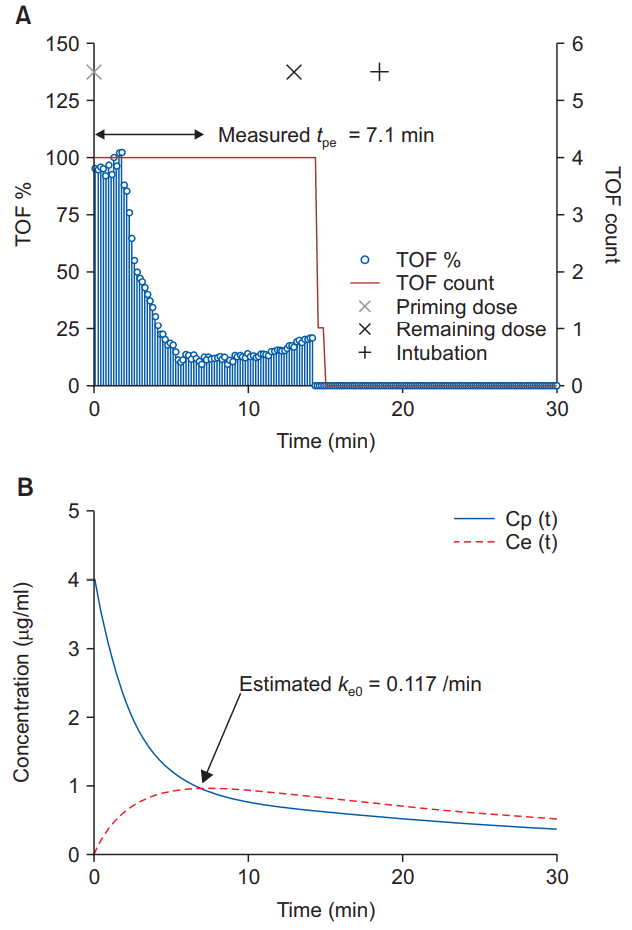1. Han DW. Pharmacokinetic and pharmacodynamic modeling in anesthetic field. Anesth Pain Med. 2014; 9:77–86.
2. Cortínez LI, Nazar C, Muñoz HR. Estimation of the plasma effect-site equilibration rate constant (ke0) of rocuronium by the time of maximum effect: a comparison with non-parametric and parametric approaches. Br J Anaesth. 2007; 99:679–85.
3. Minto CF, Schnider TW, Gregg KM, Henthorn TK, Shafer SL. Using the time of maximum effect site concentration to combine pharmacokinetics and pharmacodynamics. Anesthesiology. 2003; 99:324–33.

4. van Meurs WL, Nikkelen E, Good ML. Pharmacokinetic-pharmacodynamic model for educational simulations. IEEE Trans Biomed Eng. 1998; 45:582–90.

5. Park JC, Park KS. Comparison of pharmacodynamics and intubation conditions of muscle relaxants using a continuous infusion during induction. Korean J Anesthesiol. 2006; 50:250–5.

6. Roy JJ, Donati F, Boismenu D, Varin F. Concentration-effect relation of succinylcholine chloride during propofol anesthesia. Anesthesiology. 2002; 97:1082–92.

7. Dragne A, Varin F, Plaud B, Donati F. Rocuronium pharmacokinetic-pharmacodynamic relationship under stable propofol or isoflurane anesthesia. Can J Anaesth. 2002; 49:353–60.

8. Donati F, Gill SS, Bevan DR, Ducharme J, Theoret Y, Varin F. Pharmacokinetics and pharmacodynamics of atracurium with and without previous suxamethonium administration. Br J Anaesth. 1991; 66:557–61.

9. Alloul K, Whalley DG, Shutway F, Ebrahim Z, Varin F. Pharmacokinetic origin of carbamazepine-induced resistance to vecuronium neuromuscular blockade in anesthetized patients. Anesthesiology. 1996; 84:330–9.
10. Park JC. How to design intravenous anesthetic dose regimens based on pharmacokinetics and pharmacodynamics principles. Anesth Pain Med. 2015; 10:235–44.

11. Ali HH, Utting JE, Gray TC. Quantitative assessment of residual antidepolarizing block. I. Br J Anaesth. 1971; 43:473–7.
12. Ali HH, Utting JE, Gray TC. Quantitative assessment of residual antidepolarizing block. II. Br J Anaesth. 1971; 43:478–85.
13. Morgan GE, Mikhail MS, Murray MJ, Kleinman W, Nitti GJ, Nitti JT, et al. Clinical Anesthesiology. 5th ed. New York: McGraw-hill;2002. p. 228.
14. Jung W, Hwang M, Won YJ, Lim BG, Kong MH, Lee IO. Comparison of clinical validation of acceleromyography and electromyography in children who were administered rocuronium during general anesthesia: a prospective double-blinded randomized study. Korean J Anesthesiol. 2016; 69:21–6.

15. Gaffar EA, Fattah SA, Atef HM, Omera MA, Abdel-Aziz MA. Kinemyography (KMG) versus Electromyography (EMG) neuromuscular monitoring in pediatric patients receiving cisatracurium during general anesthesia. Egypt J Anaesth. 2013; 29:247–53.

16. Trager G, Michaud G, Deschamps S, Hemmerling TM. Comparison of phonomyography, kinemyography and mechanomyography for neuromuscular monitoring. Can J Anaesth. 2006; 53:130–5.

17. Son HJ, Lee JH, Park SW, Cho DS. The comparison among mechanical, electromyographic and accelerographic responses during recovery from vecuronium induced neuromuscular blockade. Korean J Anesthesiol. 1993; 26:910–8.

18. Salminen J, van Gils M, Paloheimo M, Yli-Hankala A. Comparison of train-of-four ratios measured with Datex-Ohmeda’s M-NMT MechanoSensorTM and M-NMT ElectroSensorTM. J Clin Monit Comput. 2016; 30:295–300.
19. Billard V, Gambus PL, Chamoun N, Stanski DR, Shafer SL. A comparison of spectral edge, delta power, and bispectral index as EEG measures of alfentanil, propofol, and midazolam drug effect. Clin Pharmacol Ther. 1997; 61:45–58.

20. Wierda JM, Kleef UW, Lambalk LM, Kloppenburg WD, Agoston S. The pharmacodynamics and pharmacokinetics of Org 9426, a new nondepolarizing neuromuscular blocking agent, in patients anaesthetized with nitrous oxide, halothane and fentanyl. Can J Anaesth. 1991; 38:430–5.

21. Kitts JB, Fisher DM, Canfell PC, Spellman MJ, Caldwell JE, Heier T, et al. Pharmacokinetics and pharmacodynamics of atracurium in the elderly. Anesthesiology. 1990; 72:272–5.

22. Sohn YJ, Bencini AF, Scaf AH, Kersten UW, Agoston S. Comparative pharmacokinetics and dynamics of vecuronium and pancuronium in anesthetized patients. Anesth Analg. 1986; 65:233–9.

23. Roy JJ, Varin F. Physicochemical properties of neuromuscular blocking agents and their impact on the pharmacokinetic-pharmacodynamic relationship. Br J Anaesth. 2004; 93:241–8.






 PDF
PDF Citation
Citation Print
Print



 XML Download
XML Download